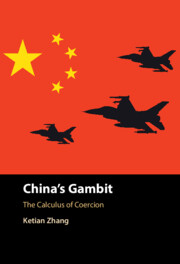Book contents
- China’s Gambit
- China’s Gambit
- Copyright page
- Dedication
- Contents
- Figures
- Acknowledgments
- Abbreviations
- 1 Introduction
- 2 The Cost-Balancing Theory
- 3 Coercion in the South China Sea
- 4 Sino-Japanese Disputes in the East China Sea
- 5 Coercion in Cross-Strait Relations
- 6 Tibet and the Dalai Lama Visits
- 7 Conclusion
- References
- Index
2 - The Cost-Balancing Theory
Published online by Cambridge University Press: 30 November 2023
- China’s Gambit
- China’s Gambit
- Copyright page
- Dedication
- Contents
- Figures
- Acknowledgments
- Abbreviations
- 1 Introduction
- 2 The Cost-Balancing Theory
- 3 Coercion in the South China Sea
- 4 Sino-Japanese Disputes in the East China Sea
- 5 Coercion in Cross-Strait Relations
- 6 Tibet and the Dalai Lama Visits
- 7 Conclusion
- References
- Index
Summary
Chapter 2 discusses the literature, the cost-balancing theory, observable implications, alternative explanations, measurement, and research design. Coercion is the use or threats of negative means to demand a change in the behavior of a target state. The underlying assumption of this book is that in an era of global economic interdependence through the intricate global supply chains and global financial network, coercion decisions are a result of balancing security and economic factors. China coerces when the need to establish a reputation for resolve is high and the economic cost is low. China will refrain from coercion when the economic cost is high and the need to establish resolve is low. In circumstances when both the need to establish resolve and economic costs are high, China will only use coercion when the importance of the issue at hand is high. As for the choices of coercion, all else being equal, nonmilitary coercion should generate lower geopolitical backlash. China is much more likely to choose nonmilitary coercive tools like diplomatic sanctions, economic sanctions, and gray-zone coercion when the geopolitical backlash is high.
- Type
- Chapter
- Information
- China's GambitThe Calculus of Coercion, pp. 13 - 45Publisher: Cambridge University PressPrint publication year: 2023

